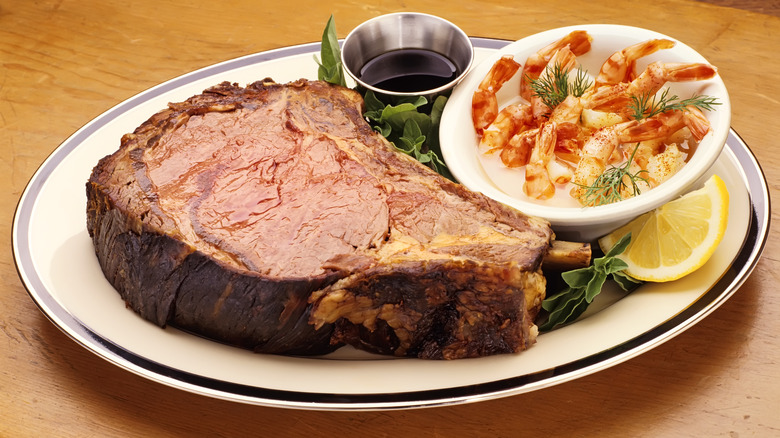The Shopping Tip To Keep In Your Back Pocket When Buying Prime Rib
Prime ribs are a delicacy for many, and although it can be easy to cook the perfect prime rib, it can be tricky to purchase. Choosing the best cut of prime rib you can afford is crucial to ensuring the main course is a showstopper at your holiday dinner party. There are many variables to consider; for instance, pay attention to the meat's grade, which determines how tender the meat will be.
USDA Prime grade, which identifies the quality, not the cut, of meat, is the highest rank, with USDA Choice coming in second. Both grades have more marbling (fat) than lower grades, meaning a juicier roast. You might want to consider buying a big prime rib since larger cuts are often more tolerant of accidental overcooking. Generally, you want to plan on serving approximately ½ to 1 pound of meat per person. You can select between a bone-in or a boneless prime rib roast, bone-in prime ribs are typically more tender.
However, if you want prime rib that's both juicy and flavorful, the secret is in how well it's aged. Try to find a prime rib that's been wet-aged, specifically, one that's been wet-aged for at least 28 days. There's a simple reason for this — the longer prime rib is wet-aged, the more tender the piece of meat will be. So prime rib that's been aged for 28 days will be softer than meat that has been wet-aged for only a couple of days, or not aged at all.
What is wet-aged prime rib, and where to find it?
Wet aging involves putting meat into a cryovac bag that has been vacuum-sealed to remove the oxygen, which slows the growth of pathogens. The meat rests in its juices for a minimum of 10 to 14 days in a refrigerator, which allows the enzymes to start to break down and tenderize the proteins and connective tissues in the meat.
It's a fairly new form of preparing meat, at least compared to other age-old methods, first becoming popular in the 1960s. The meat processing plant will typically put the meat into these cryovac bags before sending it to the butcher, or it can also be wet-aged by butchers for as long as 42 days. Finding wet-aged beef at your local grocery store might be difficult. Most larger grocery chains want to move large volumes of meat, so there's more focus on selling meat quickly, and wet aging is a time-consuming process. If you're struggling to find wet-aged prime rib, you may need to visit a local butcher shop. Wet-aged meats will likely be labeled and the label usually includes the number of days the meat has been aged.
Wet aging vs dry aging
Wet aging isn't the only aging method used to tenderize prime rib steaks. Dry-aging prime ribs also offer results in tender, melt-in-your-mouth meat; indeed, dry aging is considered by some gourmands to produce a higher quality of taste than wet aging. Dry-aged meats are aged in cold spaces with circulating air. Since the meat isn't aged in its juices, dry-aged meats will have less moisture and be drier than wet-aged meats. Dry-aged beef can lose up to 30% of its volume due to moisture loss, meaning dry-aged prime rib won't be as juicy as wet-aged, but it will be more tender.
Dry-aged prime rib roasts also have a stronger flavor than wet-aged. Some people report that the flavor tends to be slightly nutty which goes well with the meaty heartiness. However, not everyone is a fan of how this method changes the taste of the meat, with some finding dry-aged meat has a slightly funky taste. Wet-aged steaks will have a flavor similar to unaged beef. Likewise, price can also play a factor in your decision. Generally, dry-aged meat is more expensive than unaged or wet-aged beef because it takes so long to process, usually several weeks.
Finding a USDA Prime, wet-aged prime rib roast might take a bit of sleuthing and cost a bit more than a lower grade that's not been aged. But serving and enjoying a succulent prime rib that will truly impress your family and friends is worth the extra effort.


